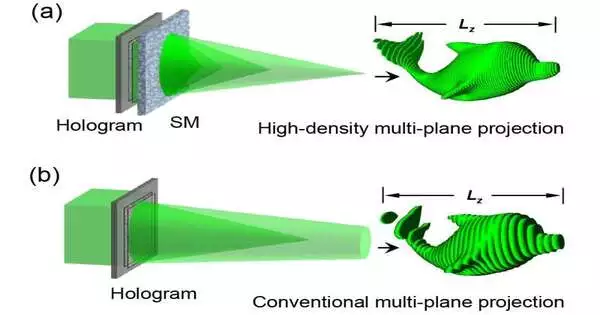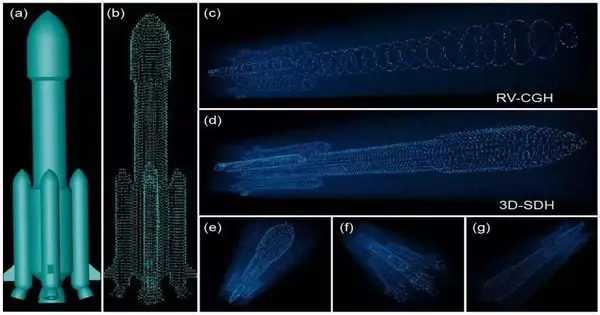Dynamic ultrahigh-density 3D holographic projections can now be made in a novel way, according to researchers. This kind of hologram could enable realistic representations of the world around us for use in virtual reality and other applications by cramming more details into a 3D image.
Lei Gong, the head of a research team from the University of Science and Technology of China, claimed that a 3D hologram could display genuine 3D scenes with continuous and fine details. “For virtual reality, our method could be applied with headset-based holographic displays to significantly improve the viewing angles, which would improve the 3D viewing experience. Additionally, it might offer better 3D images without the need for a headset.
“Our new method overcomes two long-standing bottlenecks in current digital holographic techniques—low axial resolution and high interplane crosstalk—that prevent fine depth control of the hologram and thus limit the quality of the 3D display,”
Lei Gong, who led a research team from the University of Science and Technology of China.
In order to create a holographic display of 3D objects that looks realistic, it is necessary to project images with a high pixel resolution onto numerous successive planes, or layers, that are closely spaced from one another. In order to provide the depth cues that give the hologram a three-dimensional appearance, high depth resolution must be achieved.
The National University of Singapore’s Chengwei Qiu and Gong research teams describe their novel method, dubbed three-dimensional scattering-assisted dynamic holography (3D-SDH), in the journal Optica. They demonstrate that it can achieve a depth resolution more than three orders of magnitude higher than cutting-edge techniques for multiplane holographic projection.
Low axial resolution and high interplane crosstalk, two long-standing bottlenecks in current digital holographic techniques that prevent fine depth control of the hologram and consequently lower the quality of the 3D display, are overcome by our new method, according to Gong. “By enabling more data to be encrypted in the hologram, our method may also enhance holography-based optical encryption.”.

In comparison to traditional holography methods, the new 3D scattering-assisted dynamic holography method projects high-resolution images onto closely spaced planes (a) to produce a digital hologram (b). Credit: Lei Gong, University of Science and Technology of China
Increasing the level of hologram detail.
A spatial light modulator (SLM) is typically used to modulate a light beam’s intensity and/or phase in order to produce a dynamic holographic projection. Since only a few low-resolution images can currently be projected onto separate planes with low depth resolution using current SLM technology, the quality of today’s holograms is constrained.
The researchers combined an SLM with a diffuser, which allows multiple image planes to be separated by a lot less distance without being constrained by the SLM’s characteristics, to solve this issue. Ultrahigh-density 3D holographic projection is made possible by this setup by suppressing crosstalk between the planes as well as utilizing light scattering and wavefront shaping.
The researchers first put the new technique to the test by using simulations to demonstrate that it could generate 3D reconstructions with a much smaller depth interval between each plane. They were able to project a 3D rocket model, for instance, with 125 successive image planes at a depth interval of 0.96 mm in a single 1000-pixel hologram, as opposed to 32 image planes at a depth interval of 3.75 mm using a different recently developed method called random vector-based computer-generated holography.

The researchers created a holographic simulation of a rocket using their novel technique [the drawing shown in (a) and the point-cloud model in (b)]. The volume-rendered image of the 3D rocket created by the random vector-based computer-generated holography (RV-CGH) technique is displayed in (c) using a single 10000-pixel hologram. 32 images with a 3-point, 75-mm depth interval are used to represent the 3D projection. The object projected by 3D-SDH is depicted in (d) as a volume-rendered image. A single 1,000 by 1,000 pixel hologram is used to simultaneously project 125 image planes with a uniform distance of 0 mm. The images in (e–g) show volume-rendered representations of the simulated 3D rocket from various perspective views. Credit: Lei Gong, University of Science and Technology of China
They built a prototype 3D-SDH projector to produce dynamic 3D projections and compared it to a conventional state-of-the-art setup for 3D Fresnel computer-generated holography in order to experimentally validate the theory. They demonstrated how the axial resolution of 3D-SDH outperformed its conventional counterpart by more than three orders of magnitude.
The 3D holograms that the researchers showcased are all point-cloud 3D images, so they are unable to display the solid body of a 3D object. In the end, the researchers hope to be able to use holograms to project a group of 3D objects; however, this will require a hologram with a higher pixel count and new algorithms.
More information: Panpan Yu et al, Ultrahigh-density 3D Holographic Projection by Scattering-assisted Dynamic Holography, Optica (2023). DOI: 10.1364/OPTICA.483057




